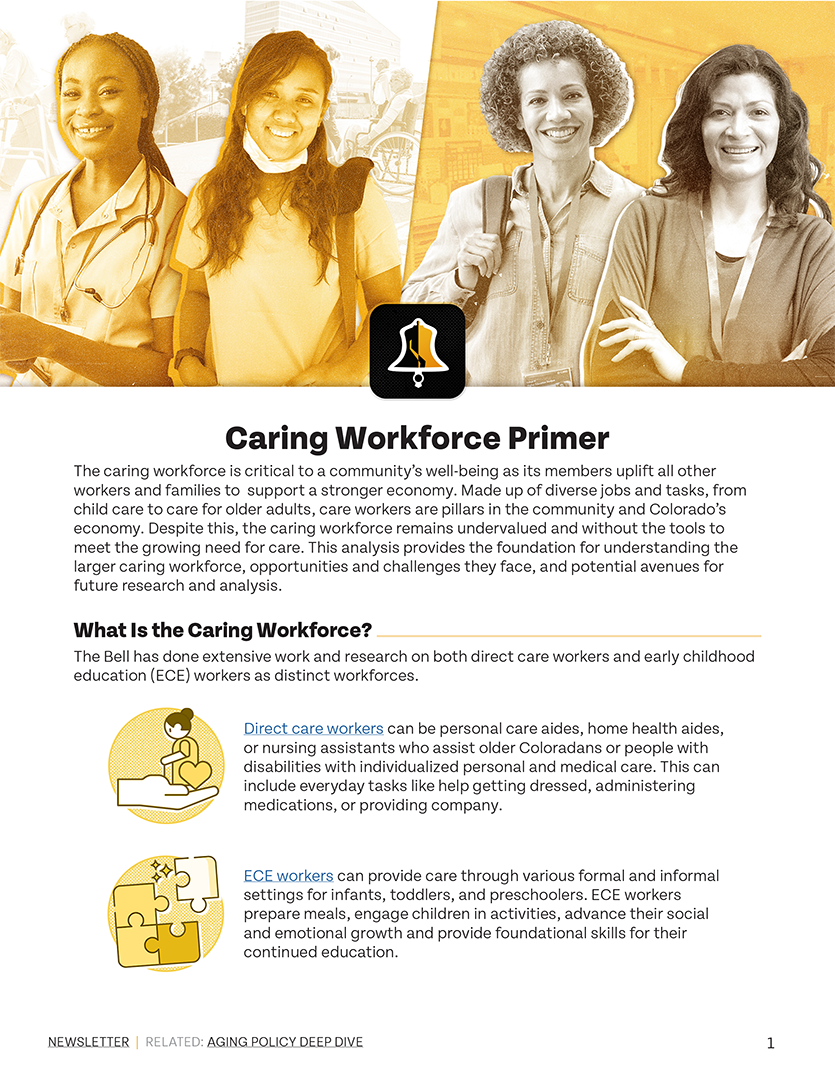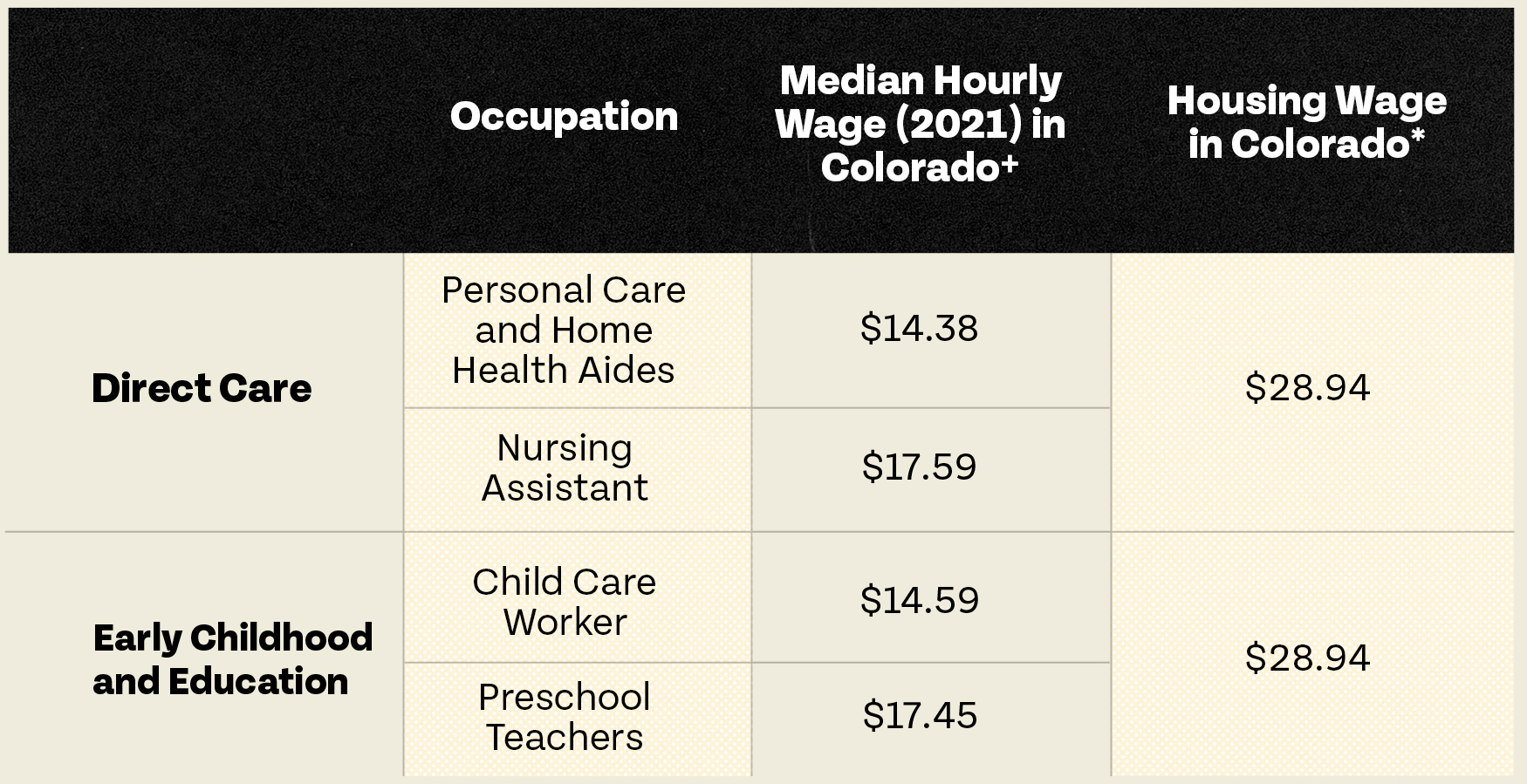Caring Workforce Primer
Caring Workforce Primer
The caring workforce is critical to a community’s well-being as its members uplift all other workers and families to support a stronger economy. Made up of diverse jobs and tasks, from child care to care for older adults, care workers are pillars in the community and Colorado’s economy. Despite this, the caring workforce remains undervalued and without the tools to meet the growing need for care. This analysis provides the foundation for understanding the larger caring workforce, opportunities and challenges faced, and potential avenues for future research and analysis.
What Is the Caring Workforce?
The Bell has done extensive work and research on both direct care workers and early childhood education (ECE) workers as distinct workforces.
Direct Care Workers
Direct care workers can be personal care aides, home health aides, or nursing assistants who assist older Coloradans or people with disabilities with individualized personal and medical care. This can include everyday tasks like help getting dressed, administering medications, or providing company.
Early Childhood Education Workers
ECE workers can provide care through various formal and informal settings for infants, toddlers, and preschoolers. ECE workers prepare meals, engage children in activities, advance their social and emotional growth and provide foundational skills for their continued education.
While the specific tasks they perform or training they undergo can look different, commonalities between these workers have become apparent throughout our analyses, and together make up the larger caring workforce. The Bell seeks to analyze these workforces jointly, as they are both critically important to the state’s well-being, and there may be opportunities to translate support strategies from one to the other. Care work largely refers to the work that is often performed “behind the scenes” and allows other work to happen smoothly and consistently. The caring workforce is what allows family members and parents to go to work every day knowing that their loved ones, across generations, are cared for.
Why Does the Caring Workforce Matter?
Supporting the caring workforce has reverberating positive effects. A robust caring workforce supports gender and racial equity, promotes good wages and benefits, will increase quality care, and spur greater economic mobility—all of which are interrelated.
Women, particularly women of color, underpin the care economy. They are disproportionately represented in the caring workforce where they experience low wages, few workplace protections, and little opportunity for career development. Supporting the caring workforce with good wages and benefits or professional development opportunities particularly benefits marginalized communities and fosters greater economic security along gender and racial lines.
Supporting the caring workforce is an equity issue for those receiving care as well. A sustainable caring workforce translates into families’ ability to access care. Care workers are crucial for keeping others active in the labor market. During the onset of the COVID-19 pandemic, record numbers of people, disproportionately women of color, left the workforce as schools and care centers closed their doors. Strengthening the caring workforce fosters greater economic mobility, an effect that goes beyond care workers. However, while people of color in the caring workforce have fewer opportunities for advancement, it is also true that families of color have less access to care. A healthier caring workforce, with additional resources and higher wages, will be able to serve more children, families, and older adults, have resources to provide culturally appropriate care, and the necessary investments to ensure affordable care.
Uplifting the caring workforce will also increase retention, further improving the quality of care. High turnover disrupts care, and it means that already scarce resources are spent hiring and training new employees. Higher retention rates are both more cost efficient and result in better care. Stability in early care and education is important for young children’s social development and their future academic success. Additionally, relationship building is a major component of a care worker’s ability to provide quality care, which is difficult with high turnover.
The Current State of Colorado’s Care Economy
Workers in the care economy, whether working with older or younger Coloradans, share many challenges that have made the caring workforce difficult to sustain. They experience low wages, a lack of benefits, few workplace protections, and as a result, have high turnover rates.
With median hourly wages ranging between $14 and $17, many care workers struggle to afford necessities such as housing. To supplement their wages, 6.4 percent of personal care and nursing aides, nationally, hold second jobs, which is 35 percent higher than other workers. Notably, 41 percent of Colorado’s direct care workers rely on public assistance, including cash and food assistance to help make ends meet.
In addition to low wages, 11 percent of Colorado’s direct care workers do not have health insurance, and 36 percent rely on Medicaid or other public coverage. Direct care workers and child care workers are also less likely to have access to retirement plans and paid leave— only 1 in 10 child care workers has retirement benefits. This trend varies depending on the specific job. For example, a worker in a private household, is significantly less likely to have retirement benefits compared to a care worker in a nursing facility or child care center.
It should be noted that in 2020, significant improvements were made to address disparities in benefits in the state of Colorado. The Colorado SecureSavings Program allows employees to save for a retirement in a Roth IRA if their employers do not have retirement plans. It is a portable benefit, meaning workers can carry this plan with them in a new or different job. Colorado also passed the Family and Medical Leave Insurance program, which ensures that all Colorado workers can access paid leave, though these benefits will not be accessible to individuals until 2024. These programs certainly benefit care workers, however, the implementation of these programs is crucial to their success. Information about the programs and eligibility need to be widespread and easily accessible to ensure there is widespread use of these programs as well as a workplace culture that ensures employees feel comfortable taking leave when they need to.
With high turnover rates and little incentive to join the caring economy, Colorado ends up with an important worker shortage. Nationally, using the Bureau of Labor Statistics, the U.S. Chamber of Commerce estimated a worker shortage index of 0.5 in the education and health services sector. This means that in 2021, there were double the number of job openings (from both growth and replacement needs) as compared to the number of unemployed workers in the sector, making it the industry with the second highest worker shortage. This isn’t solely attributable to the caring workforce as other occupations, such as postsecondary education and primary medical care, also contribute to the education and health services sector. However, in Colorado, this trend is likely very similar for care work, especially with the second fastest aging population in the country and as Colorado’s population of children under 4 years old is expected to grow by 22 percent by 2026. Colorado’s population of people 65 and older is expected to grow 49 percent while the 16 to 64 year old population (the labor pool) is only expected to grow 14 percent. This indicates a high potential for a direct care worker shortage in Colorado. Additionally, 70 percent of ECE program directors in Colorado reported having difficulty hiring staff. Colorado’s worker shortage is compounded by an expected increase in care worker demand that is projected to outpace national growth.
The graph above illustrates the projected growth Colorado will see in care jobs from 2020 to 2030 compared to the national projected growth in care jobs from 2021 to 2031. Colorado has a heightened need for care workers and will continue to need them as the economy continues to grow.
Despite chronically low wages for care workers, care is still unaffordable for too many. In previous research, the Bell calculated a cost model for child care in Colorado and found that families spend 16 to 27 percent of their income on child care. According to the U.S. Department of Health and Human Services, affordable child care should account for 7 percent of a family’s income. Although the cost of care for families is high, ECE providers are operating on thin margins with labor as the largest expense. Care remains a critical service that people rely on, yet care workers receive low wages, and providers can’t afford to pay them more without raising costs that are already difficult for families to afford. Greater public intervention is necessary to better support care workers and our communities.
The caring industry relies on public funding, some of which ease the burdens of affordability. ECE relies on a mix of federal funds, like Child Care Development Block Grants and Head Start, state, and local funds. For home health workers, significant funding comes from Medicaid reimbursements, which is also a mix of state and federal funds. The precedent and infrastructure for public funding to the caring workforce already exists, and given the continued challenges of accessibility, affordability, and persistent growth in this sector, continued and increased public funding will be necessary.

Looking Forward
The care economy and the caring workforce are integral to Colorado’s economic wellbeing. With dual pressures of an expanding aging population and an urgent need to increase the affordability of child care, Colorado is at a critical juncture and has the opportunity to better sustain its caring workforce. While there has been recent attention on the caring workforce after the COVID-19 pandemic, it remains systematically undervalued and underpaid. Pursuing sustainable long-term solutions for the caring workforce are essential. To continue this effort, the Bell has outlined potential future avenues for research, analysis, and advocacy:
Click to Expand:
- What does the public funding infrastructure look like? What is the need?
- How does public funding affect care workers’ ability to be paid fair and living wages?
- How will we ensure an adequate workforce for supporting our state’s guarantee of 10 hours of universal preschool and supporting the need for infant and toddler care?
- How will we meet the home care needs of our aging population?
- How might Family, friend, and neighbor (FFN) care be a resource to better meet needs in care work?
- What is the proportion of independent contractors in the caring workforce?
- Who is providing care and who is accessing care and how can we better target support?
- What does the FFN care landscape look like? Who provides FFN care and who uses FFN care?
- What are the costs of not supporting the caring workforce?




